Baptistery (19th century)
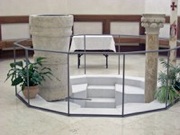
The twelve-sided baptistery is immediately to the left of the main entrance. The present font is arranged to allow full immersion, and it incorporates a column (10th century) from Santa Maria Assunta in Pieve Fanonica.
Original Chapel
The present baptistery was built on the site of an ancient chapel. Ludovico Jacobilli recorded (in 1626) the Compagnia della Carità (also known as the Compagnia dei Preti) had built it in 1385 and dedicated to their patrons, both of whom were from Foligno: the Blessed Peter Crisci and St Dominic of Sora. The relics of the former were housed here in a reliquary made of crystal and gold. The inventory that was compiled in 1771 recorded that the relics were removed from the chapel on 26th August of that year. It was presumably at about this time that they were transferred to the present gilded wooden reliquary and moved to the Cappella Jacobilli (below).
This inventory added the information that this chapel also housed the fonte, and a very ancient image known as the Madonna della Febre (Madonna of the Fever), which was presumably particularly venerated at times of sickness or epidemic.
Art from the Chapel
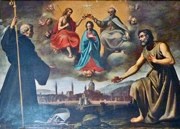
In 1626, Ludovico Jacobilli requested permission from the Cathedral Chapter to place “il quadro del Beato Pietro Crisci” in the Cappella di San Domenico di Sora e il Beato Pietro Crisci. This was almost certainly the altarpiece illustrated above of the Coronation of the Virgin and St Dominic of Sora and the Blessed Peter Crisci, which is attributed to Noel Quillerier and which is now in the Museo Diocesano.
Cappella Jacobilli (16th century)
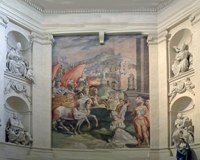
This lozenge-shaped chapel was built (or perhaps rebuilt) off the right wall of the left transept. As noted above, designs (ca. 1520) by Antonio da Sangallo il Giovane for it survive in the Uffizi Gallery, Florence. It belonged to the Confraternita del Corpus Domini at that time, but passed to the Jacobilli family in 1586 and was rededicated to SS Felician and Francis.
As noted above, the relics of the Blessed Peter Crisci were removed from their original chapel on 26th August 1771. It was presumably at about this time that they were transferred to the present gilded wooden reliquary and moved to the altar of this chapel. The relics were removed for scientific investigation in October 2009 and returned to the reliquary, which is now in the left transept.

Scenes from the Martyrdom of St Felician (ca. 1600)
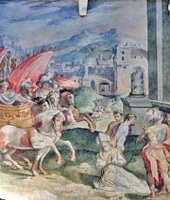
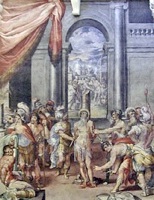
The frescoes on the side walls of the chapel, which are attributed to Vespasiano Strada depict:
-
✴the capture of St Felician, on the left; and
-
✴his trial (in the scene under the arch) and execution by burning, on the right.
A design for the second fresco survives in the Musée du Louvre, Paris.
Art from the Chapel
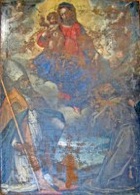
The altarpiece was cut down and badly damaged in 1771, when it was moved to the sacristy. It depicts the Madonna and Child seated on clouds while SS Felician and Francis below commend the city to their care.



